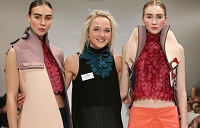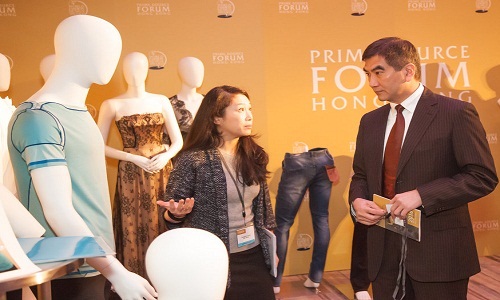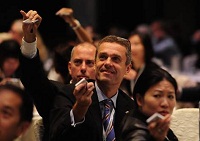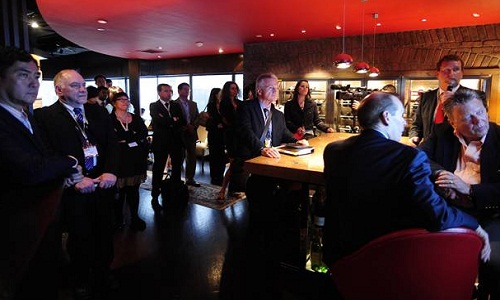FW
"Co-located with 12th Prime Source Forum, the annual meeting place for the global fashion industry, World Fashion Design Competition (WFDA) is slated for March 13-14, 2017 at The Langham Hong Kong. This is a B2B platform offering producers opportunities to demonstrate their capabilities of manufacturing designed fashion items from around the world under one roof. Unlike other fashion design competitions, WFDA focuses on collaboration amongst producers, designers and buying offices of multinational brands or e-tailers."

Co-located with 12th Prime Source Forum, the annual meeting place for the global fashion industry, World Fashion Design Competition (WFDA) is slated for March 13-14, 2017 at The Langham Hong Kong. This is a B2B platform offering producers opportunities to demonstrate their capabilities of manufacturing designed fashion items from around the world under one roof. Unlike other fashion design competitions, WFDA focuses on collaboration amongst producers, designers and buying offices of multinational brands or e-tailers.

“Sourcing managers at my level or in senior positions no longer visit local and overseas trade fairs to source new products. We consider new suppliers by existing connections, selected referrals or find them at high-level conferences. Ideally, new suppliers are coming to us to showcase their innovations so that we can make decisions here immediately,” opines a sourcing executive of one of the top three apparel retailers in Europe.
The pattern of the fashion sourcing world is changing. Nowadays, suppliers take more initiative to present their ready-designed or ready-for-adjustment products to clients for critique or selection. A stronger, reliable and allied partnership between buying offices and suppliers is needed. “With the aim of strengthening the undivided buyer-supplier relationship, for its first debut, we launched the World Fashion Design Competition and Award (WFDA) at the signature event of the fashion industry, Prime Source Forum Hong Kong in March 2016,” explained Martin Keil, MD, Yeh Shen.
The Objective
With increasing number of design programs launched around the world, one can see more and more qualified designers who have graduated from top fashion institutes looking for opportunities to show off their talent. How to win orders amid the gloomy global economy and sluggish fashion sales is the key to success. Strengthening design capabilities to outpace the rivalry seems a win-win approach. Thus, WFDA emerges to fill this gap – to synergise the collaboration between fashion designers and producers in order to provide international brands and e-tailers with a broader selection. WFDA is an international event. Members of industry associations, designers from fashion schools, governmental agencies or even individuals from around the world are welcomed to participate in WFDA to work towards enhancing the global fashion industry together. Renowned designers, chief editors of fashion magazines, senior executives of sourcing and product development departments of fashion brands and retailers form the part of distinguished judges.
The Participants
Fashion producers from the global supply chain have participated in this international Award and Competition. As buying offices will contact producers to place orders of any appropriate fashion items found during the two-day event, competition registration will be in the name of the producers’ organisations for easy operation. Nonetheless, young designers from fashion institutions and universities are encouraged to work with producers to apply for the competition, or to contact their institutes or universities for pairing with producers. Participating companies are categorised into two main groups according to their designers’ working experience: group A: Designers are under/post-graduates with maximum three years’ working experience; and group B: Designers have more than three years’ working experience in fashion design.
Competition Categories
Participating items will be classified into: fashionCHIC – Contemporary fashion; fashionCLUE – Solutions for fashion production or supply chain; fashionDECO – Fashion accessories, including footwear or carrying items; fashionKIDS – Fashion for our future; and fashionTECH – Fashion in wearable technology. The selection criteria is based on these parameters: 20 per cent aesthetic; 20 per cent functionality; 20 per cent innovation; 20 per cent sustainability and 20 per cent commercialisation. Amongst all participating items, five special awards will be given to winners who receive the highest scores on the above criteria. In addition to these awards, overall winner of the competition will be presented to the company that wins the most awards overall. A special award, ‘Country of the Year’, will also be given to the country representative in recognition of the best efforts and keenest participation of the country represented.
The first WFDA is aimed at getting fashion producers’ efforts-of-the-years acknowledged and recognised by the industry and showcase their abilities to design to senior executives of buying houses attending PSF. WFDA will act as a springboard for future business collaborations. Other advantages include promoting the latest collection of the designed products; generating possible leads through interaction with judges and other participants; interacting with decision makers over the two-day Forum and acquiring industry updates and the wisdom of speakers through discussions at PSF. Be a part of this trade event which promises a lot more than just networking. It’s simply multiplying your business boundaries and aspirations to another level.
India’s apparel exports to the US rose 4.3 per cent y-o-y in January 2017. Export volumes increased 8.6 per cent but export realisation fell four per cent. India replaced Mexico as the fifth largest apparel exporter to the US during the month, with a market share of 4.7 per cent.
In January 2017, China’s apparel exports to the US rose 4.6 per cent. India’s cumulative apparel exports to the US during April 2016 to January 2017 decreased by 1.9 per cent. This was on account of a 3.6 per cent fall in export realization. Export quantity grew 1.7 per cent. Despite a fall in exports, India’s market share expanded by ten basis points to 4.2 per cent.
China’s cumulative apparel exports to the US during April 2016 to January 2017 decreased eight per cent. Market share contracted 110 basis points to 35.6 per cent. Exports from Bangladesh decreased 3.8 per cent and Indonesia by 4.9 per cent. The market share of both these countries remained unchanged at 6.3 per cent and 5.7 per cent. Vietnam witnessed a three per cent rise in exports. The country’s market share expanded 100 basis points to 13.6 per cent.
Textile mills in Tamil Nadu want the hiked VAT on petrol and diesel to be withdrawn. VAT has been increased on diesel from 21.43 per cent to 25 per cent, which has pushed up its price by Rs 1.76 a liter; and on petrol from 27 per cent to 34 per cent, which has pushed up its price by Rs 3.77 a liter.
Mills say the hike is unwarranted since GST is likely any time soon. They feel this would impact the textile industry. The present hike in VAT would have a considerable impact on the transport cost of all items as textile clusters of different value segments are located in different places and with the mill sector using diesel generators to tide over load shedding and tripping it could increase the power cost as well.
The textile industry in Tamil Nadu feels while other states enjoy huge incentives it is already in a disadvantageous position as the spinning sector spends around Rs 6 per kg to procure the raw material from upcountry markets and another Rs 4 per kg to sell the yarn in those markets. Tamil Nadu has some 2,000 textile mills, which are predominantly spinning-oriented.
India’s cotton yarn output may decline five to seven per cent for the financial year 2016-17. Sluggish demand is partly due to the substitution taking place from manmade fibers. However, yarn demand from overseas buyers has revived in the last few weeks. It was sluggish so far since importers withheld orders in anticipation of a price dip. But now they realize cotton prices are not going to come down. So they are booking cotton and cotton yarn.
And with Chinese cotton auction starting at a 25 per cent premium over the prevailing fiber rate in India, Indian exporters are hoping to see a revival in cotton yarn exports. Cotton yarn exports are expected to turn positive this year after a steep decline last year.
Meanwhile cotton yarn demand from domestic mills has also revived. Spinning mills want a two per cent tax benefit on yarns under the Merchandise Exports from India Scheme. For April to December 2016, India’s cotton yarn exports fell by 12 per cent compared to the corresponding period last year. Cotton yarn exports from India rose by a marginal 4.29 per cent in financial year 2015-16 compared to the previous year.
Victoria’s Secret has opened a store in China. Fronted by an iconic pink glass facade, the four-storey Victoria’s Secret store occupies 2,500 sq. mt. This is Victoria’s Secret first store in China. Prior to this, the US brand had only operated concept stores in China, selling branded accessories. By the end of 2017, Victoria’s Secret will open one more store in China and will host a lingerie and underwear show. Almost two decades of breakneck economic growth and increasing prosperity have got Chinese women accustomed to western tastes and fashion sensibilities.
The opening of this store is expected to satisfy Chinese women’s desire to keep up with the pace at the forefront of international fashion. Luxury lingerie and high quality functional products are becoming increasingly popular among Chinese women. International brands see China as a priority to help bolster overall sales given a fairly bleak global outlook. Top Italian luxury lingerie maker La Perla, which has eight stores in China, is planning additional outlets. Germany’s Triumph too is adding stores.
China’s market for women’s underwear is expected to have a retail value of 25 billion dollars by 2017 - double that of the United States - and is expected to grow to 33 billion dollars by 2020.
The garment-making sector in east China’s Zhejiang province is undergoing a difficult time as profits continue to shrink. Some factories have closed due to rising labor costs. Most clothing factories are original equipment manufacturers. In the last two years, with high product inventories and rising competition, many garment producers floundered.
Some have cut their cloth manufacturing business to focus on cloth materials. Some others that used to export women’s clothing to the US and Europe are seeing a dip in profits. A garment factory which primarily makes suits, shirts and business clothes no longer has a cost advantage over competitors in countries such as Cambodia and Vietnam. It exports 40 per cent fewer products than a few years ago and has had to cut the number of workers.
The number of clothing companies in the province has shrunk to 200 or 300 from a peak of about 650. There are more than 1,00,000 garment manufacturers in China employing over ten million people. The country is the largest manufacturer, exporter and consumer of garment products in the world.
There are over 50 garment clusters characterized by product categories all over China. The garment industry is making progress in many aspects such as industrial structure, technology application, brand development, quality control, profitability and exploration in domestic and international markets.
Chic will take place in Shanghai from March 15 to 17, 2017. This is a fashion trade show and acts as a mediator between the fashion industry and the fashion trade. About 1,200 exhibitors will present new trends and tendencies for fall/winter 2017/18.
Chic attracts the powerful network of Chinese fashion industry, complete Chinese retail market, including e-commerce platforms, agents, importers and influential associations for the industry, design and trade. Over 18 nations and regions, apart from mainland China, are participating. Italian participation is one of the largest among international ones with important shoes, clothing and accessories brands for men and women among the exhibitors. French participation comprises a kaleidoscope of fashion brands from ready-to-wear to accessories, shoes and bags. The German participation comprises a product variety from ready-to-wear, fur fashion to bags and shoes.
There will be 20 brands from Turkey specialized in leatherwear, furs, shoes and bags. In addition participants are coming from Spain, UK, Switzerland, Peru, Japan, Taiwan, Hong Kong, South Korea, Canada and Thailand.
Technical progress in the fashion industry will be a topic at Chic. Companies will present innovative software for multi channel solutions and customer centered service systems and 3D garment development technology.
Bangladesh’s export earnings declined 4.49 per cent year-on-year in February. Receipts for the month were 21.49 per cent less than January. The amount was also 9.64 per cent lower than the monthly target, February receipts from garment exports were 5.64 per cent lower than target. However, overall exports in July to February increased 3.22 per cent.
Apparel shipments went down due to a fall of the euro against the dollar as well as Brexit, the US elections and a decline in consumption in the West. The UK is the third largest export destination for Bangladesh. But garment shipments to the UK declined 5.19 per cent in the first half of 2016-17.
Jute and jute goods sector was one of the top export performers in the July-February period, with shipments rising 15.28 per cent year-on-year. Shipments of leather and leather goods were up 9.95 per cent year-on-year.
Furniture exports rose 16.84 per cent and exports of pharmaceuticals rose 9.94 per cent. Home textile exports increased 3.16 per cent and plastic products exports rose 39.87 per cent, riding on the back of a ten per cent cash incentive on shipments. Bangladesh’s export target for this fiscal year is eight per cent higher than the receipts in fiscal 2015-16.
The Alliance for Bangladesh Worker Safety – a platform of North American buyers – has announced that another six garment factories, which supply products for its signatory brands, have completed corrective action plans. So far the number of companies stands at 68. In addition, Alliance has dropped seven new factories from its compliant list, bringing the total number of factories suspended to 134.
Alliance is a grouping of 26 North American apparel companies, buyers and retailers. Alliance also continues to uphold accountability measures for factories that fail to prioritise remediation. Alliance performs independent inspections on structural, electrical and fire safety of all factories from which its members source their products. Based on the findings of inspection, it prescribes corrective action plans for factories to declare them compliant.
The issue of safety came under the spotlight following the factory collapse at Rana Plaza that killed over 1,135 people and injured over 2,500 workers. The incident raised question about workers’ safety and safety in workplaces. In the face of huge pressure from rights group and global trade unions from home and abroad, global retailers formed Alliance and Accord on Fire and Building Safety in Bangladesh to improve safety standards in the readymade garment sector.
"Hong Kong is getting ready for the annual Prime Source Forum from March 13-14, 2017 at the The Langham Hong Kong. Some 350 senior executives from the global fashion supply chain from raw materials to e-retail are expected to attend the two day forum."

Hong Kong is getting ready for the annual Prime Source Forum from March 13-14, 2017 at the The Langham Hong Kong. Some 350 senior executives from the global fashion supply chain from raw materials to e-retail are expected to attend the two day forum.
Since its debut in 2006, Prime Source Forum (PSF) is perceived as one of the most beneficial and effective promotional channels for the global fashion industry. Held annually in Hong Kong, PSF brings together some 400 senior executives from more than 20 countries to discuss the challenges and opportunities that manufacturers, suppliers and retailers are facing in the apparel supply chain. Perhaps, this is called a forum and not a conference as delegates involvement are an important element of its success. Prime Source Forum (PSF) is not limited to sourcing and supply chain alone it also is a valuable source of information for the fashion industry.

“Sourcing managers in my or senior levels no longer visit local and overseas trade fairs to look for new products nowadays. We consider new suppliers by existing connections, selected referrals or find them at high-end conferences. Ideally, new suppliers are coming to us and display their innovations so that we can make decisions here immediately,” explains M Lo, Sourcing Manager, Far East one Europe’s top three apparel retailers. This is why PSF is still serving the industry even after so many years.
The line up in this edition Year 2017 is shaping up to be a pivotal year for fashion industry. Topical themes and how the industry should respond to it will be covered. The keynote address will be by Colin Browne, President, Global Sourcing, Under Armour. The first session ‘Global trade – what is the regulatory landscape going to look like’ will offers suggestions to hedge against the geo-economic uncertainties in the new sourcing landscape and where we are heading with global trade will be discussed in this session. This will be followed by CEO dialogues on how digitising quality control helped Quiksilver increase supply chain transparency, supplier collaboration and employee engagement would offer industry best practices. Bart De Meirsman, MD, Quiksilver Asia Sourcing and Stephane Boivin, Co-founder, President & CEO, Pivot88 will be the main participants. Session 2 will throw light on survival under global political frictions and economic uncertainty – How we can navigate an uncertain future. Debate on ‘Sourcing 2020, what does the future fashion sourcing landscape hold?’ would help in brainstorming strategies for future. CEO Dialogue will be on ‘The future consumer; sourcing in future’ by Anson BAILEY, Principal, Business Development, KPMG.
The second day will start with a keynote address by Arkebe Oqubay, Minister and Special Advisor to the Prime Minister, the Federal Democratic Republic of Ethiopia. The following session will offer insights on the challenges and opportunities of developing the fashion supply chain in Africa as well as CEO Dialogues on sourcing responsibly in Africa. It will be followed by World Fashion Design Award Ceremony. Apart from this, there will be sessions on changes on fashion supply chain management in prevalence of e-tailing; business advancement – key to survive in the disruptive era and engaging CEO Dialogues on SAC's vision 2020 on transparency By Jason Kibbey, CEO, Sustainable Apparel Coalition. Day 2 will also have a session on ‘Changes on fashion supply chain management in prevalence of e-tailing’.
Strong line up
PSF offers ample opportunity for delegates to network with their peers, mingle with expert panelists and exchange ideas with their peers and competitors alike on issues of mutual interest. The speakers are industry leaders and key decision makers. No. of estimated registrants: Some 350 senior executives of the global fashion supply chain from raw materials to e-retail The speaker line up have names like Arkebe Oqubay, Minister and Special Advisor to the Prime Minister, the Federal Democratic Republic of Ethiopia, Phan Chi Dung, Director General, Light Industry Department, Ministry of Industry and Trade, Vietnam, Anson Bailey, Principal, Business Development, KPMG, to Brice Berrard, MD, TeamWorld, Eram Group, Anne-Laure Descours, Global Director, Sourcing Apparel, Puma, Mark Green, EVP, Global Supply Chain, PVH among many, many others.
Prime Source Forum (PSF) was initiated by APLF in 2006 to address the issue of quota elimination in the apparel industry. After its staging in the industry for eight years, PSF is now organised by YEH SHEN under licence of APLF. APLF is a joint-venture between UBM Asia and the SIC Group of France. For over two decades, Hong Kong-based APLF has been providing the global leather and fashion industries with its most important meeting and trading places. Josephine Ching, person in charge of PSF under the organisation of UBM Asia from 2007-13, is now Event Director of YEN SHEN which has been incorporated in Hong Kong since 2006. Starting from October 2013, PSF is organised by YEH SHEN under licence of APLF.












